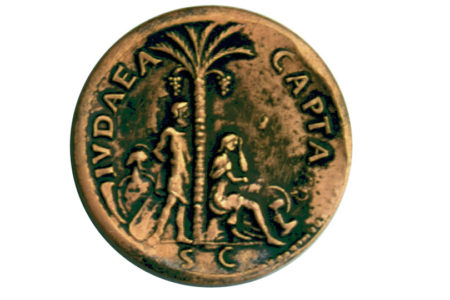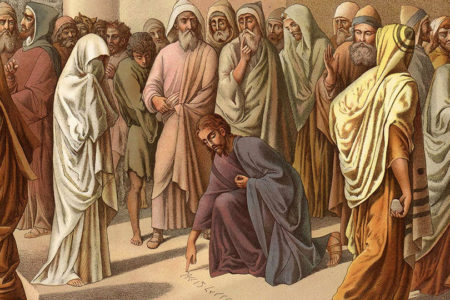Gentile Rule Over Judæa
Gentile rule over Judæa began in 605 B.C. when King Jehoiakim of Judæa became a vassal of Babylon. As pictured in Daniel’s visions of the image (Dan. 2) and the four beasts (Dan. 7), God determined that four Gentile nations would rule over Israel until the Messiah came. Babylon was the first nation to rule Israel, but because the biblical record continues until after the fall of Babylon to the rule of Medo-Persia and the returns to the land under Zerubbabel and Nehemiah, this study deals with Judæa under the rule of Persia, Greece, and Rome after the ministry of Malachi.
Judæa Under Persian Rule
The Persian King Cyrus not only conquered Babylon in 538 B.C., but in the same year he allowed the Jews to return to Jerusalem (Ezra 1:1–4; Isa. 44:28; 45:1). Persian power was maintained from 539 to 425 B.C., roughly until the end of the biblical period. From 425 B.C. until the rise of Alexander the Great of Greece, the Persian Empire was in decline.
Darius I organized the Persian Empire in 20 satrapies with a satrap in charge of each. Syria and Palestine constituted the fifth satrap, which was further subdivided into districts ruled by pashas. The district of Palestine included Judæa and Samaria, and its pasha ruled from the city of Samaria. Generally speaking, Persian rule over Judæa was very tolerant. The Jews were allowed to rebuild Jerusalem and the Temple under the leadership of the high priest and a Jewish governor, and they could worship as they pleased. However, as is evident from the Book of Esther and the apocryphal books, such as Tobit, not all Jews returned to Judæa. Some settled throughout the Persian Empire, mainly in Babylon and Egypt.
During the last century of Persian rule, the Samaritan religion was established. Apparently the contention between the governors in Samaria and Judæa continued and was exacerbated by Ezra and Nehemiah’s reforms. Nehemiah 13:28 refers to a descendent of the high priest who was driven out of Jerusalem, possibly because he had married Sanballat’s daughter and refused to divorce her. According to Josephus (Antiquities of the Jews, xi.8.2,4), this brother of Jaddua who was driven away was Manasseh, and through Sanballat’s help he was established as the high priest over a rival temple built in Shechem on Mount Gerezim. The Samaritans took the Pentateuch as their scriptures and refused to recognize Jerusalem as the place of worship designated by God. This rivalry continued until the time of Jesus.
Persian power had reached its peak in the fourth century B.C., and when King Xerxes was defeated by the Greeks at Salamis and Plataea, it marked the limit of the Persian Empire’s westward expansion. By the time of Alexander the Great, the empire was disintegrating, and the Persian king spent most of his time quelling rebellions.
Judæa Under Greek Rule
Pictured in Daniel 7 as the leopard with wings and in Daniel 8 as the goat whose feet did not touch the ground, Alexander the Great conquered the whole Persian Empire in just nine years. After defeating Darius III in Asia Minor, Alexander headed south toward Palestine and Egypt. After destroying Tyre, he came to Jerusalem and, according to Josephus (Antiquities of the Jews, xi.8.5), offered sacrifices to the God of Israel because he recognized the high priest Jaddua as the one who, before he left Macedonia, had appeared to him in a dream and commissioned him to conquer the Persians. The priest showed Alexander what was written about him in the Book of Daniel, and Alexander understood himself to be that divinely ordained person. In honor of this occurrence, he granted the Jews favor to practice their religion freely throughout the empire.
While some scholars question the historicity of Josephus’ account, Alexander certainly did act as if he were divinely ordained to rule the world, and Judaism—as well as the other Eastern religions—was not prohibited under his rule. Rather, Alexander’s vision was to unite the East and West into one culture. This meant the Hellenization of the East (i.e., the introduction of the Greek language, philosophy, and customs into the East), which continued well beyond Alexander’s death in 323 B.C.
As pictured in Daniel 7:6; 8:8; and 11:4, by 301 B.C., Alexander’s empire was divided among four generals. Ptolemy received Egypt, and Seleucus was to rule over Syria and Palestine. Before Seleucus could establish himself in Palestine, Ptolemy seized the territory, and thus Palestine became an area of contention between the two dynasties for the next 130 years (cp. Dan. 11:3–35). The Ptolemies controlled Palestine from 301 to 198 B.C., until the coming of Antiochus III, the Great.
Judæa was not as significant to the Ptolemies as the trade routes that ran along the Mediterranean coast and through the Trans-Jordan. In this respect, the Jews were able to continue their customs without interference, although some of the more wealthy and politically connected families (the Tobiads) were open to Hellenistic ways, which began to cause a division among the Jewish people. However, the freedom of religion changed with the inauguration of Seleucid rule.
Antiochus III had designs to rule over the entire Greek Empire, but he was defeated by the Romans at Magnesia in 190 B.C. As a consequence, he had to pay huge sums of money to Rome, and his sons were taken hostage by the Romans as security. To pay his debt to Rome, Antiochus and his successors began to confiscate money from the various temples under his rule, including the Temple in Jerusalem. After Antiochus III and his son, Seleucus IV, were killed, another son, Antiochus IV, who had been raised in Rome, came to power. Antiochus IV Epiphanies (manifest, i.e., manifestation of Zeus) desired to unite his father’s empire and sought to totally Hellenize Judæa.
To take control of Judæa, Antiochus deposed Onias III, the rightful Zadokite high priest, and appointed Onias’ younger brother, Jason, a Hellenistic sympathizer, as high priest when Jason offered more money for the office. Thus, in 174 B.C., the succession of Zadokite high priests in Jerusalem ended. Three years later, Jason’s friend Menelaus, who was not even of the Aaronic line, offered Antiochus more money than Jason, and Menelaus was made high priest. When Menelaus plundered the Temple, Antiochus came to rescue him and establish his control over Jerusalem. Finally, after being forced by the Romans to leave Egypt, Antiochus took out his vengeance on Judæa. He outlawed the practice of Judaism and commanded that all sacrifices be made to pagan gods. On Chislev 25, 167 B.C., Antiochus set up an image of Zeus in the Temple in Jerusalem and commanded the Jewish people to worship Zeus, which in effect was worship of himself. This is “the abomination that maketh desolate” referred to in Daniel 11:31.
At the same time, all of the priests in Judæa were commanded to offer pagan sacrifices. In the town of Modi’in, an old priest named Mattathias refused to offer the sacrifices, killed a Jew who was going to do so, along with Antiochus’ agent, and tore down the altar. Mattathias and his five sons were joined by the anti-Hellenist Hasidim, and thus began the Maccabean revolt. After defeating the Syrians at Emmaus, one of Mattathias’ sons, Judas Maccabee, restored the Temple worship on Chislev 25, 164 B.C. The Feast of Dedication or Lights (Hanukkah) commemorates this event. Following another 30 years of fighting, Judas’ brother Simon was named leader and high priest of Judæa by the Syrians in 142 B.C. Thus began 80 years of Jewish independence under the family name of Mattathias, the Hasmoneans.
While the early Hasmoneans ruled effectively, the later rulers caused much strife in Judæa. Not only did the Hasmonean rulers become wealthy and power hungry, they became less zealous for Judaism and enemies of the Pharisees. They also alienated the rightful priesthood because they were not of the Zadokite line. The Zadokite priests formed a separate community in Qumran. Conversely, the Sadducees came from those wealthy families that supported Hasmonean rule. As a result, many segments of Jewish society were looking for the promised Son of David who would come and make all things right. Ultimately, Rome conquered—piece by piece—the Greek Empire. When General Pompey subjected Palestine in 63 B.C., Jewish independence effectively ended.
Judæa Under Roman Rule
Roman rule of Palestine was much like that of the previous empires. A Roman governor or legate administered the province of Syria and Palestine from Antioch, while local kings ruled under Roman authority with the understanding that they would be loyal to Rome. The Romans were not interested in promoting any philosophical or religious agenda. Rather, their interest was simply in keeping the peace of the entire empire and receiving the nation’s loyalty and tribute.
In 37 B.C., Herod was proclaimed King of Judæa, and he ruled for 33 years. Herod the Great was hated by the Jews, and so he sought to please them by his great building projects, especially the enlargement of the Temple in Jerusalem. Herod, however, was determined to eradicate any rival claim to his throne. He eliminated any Hasmonean rival and named Ananel, a Babylonian priest, as high priest in Jerusalem in 37 B.C. From that point, the high priests in Jerusalem were appointed by the ruler of Judæa, usually through bribery by one of the many wealthy families. The house of Annas, whose son-in-law Caiaphas was high priest in Jesus’ day, was one of those families. They were not legitimate high priests according to the family of Zadok, but they sought to protect Judæa from Roman power, if only for their own self-interests. This explains why, in the New Testament, the high priests were so intent on keeping the peace and not offending their Roman rulers.
Herod the Great’s kingdom was divided among three of his sons who survived his paranoia. Archelaus received Judæa and Samaria, Herod Antipas received Galilee and Perea, and Philip received the area of lower Syria north and east of the Sea of Galilee. Archelaus was incompetent and was replaced by a Roman procurator in 6 A.D. These Roman procurators lived in Cæsarea by the Sea and were responsible to the legate to keep the peace and assure that the taxes were paid. Pontius Pilate was procurator of Judæa from 26 to 36 A.D., and his name has been found on a plaque dedicating a temple to the Emperor Tiberius in Cæsarea.
There was always opposition to Roman rule in Judæa, especially by the Zealots, who dreamed of an independent Jewish state. The Roman procurators were ruthless in their desire to maintain order. When the Roman procurator, Gessius Florus, after decades of unrest, caused riots in Cæsarea and Jerusalem in 66 A.D., the sacrifices offered on behalf of the emperor in the Temple in Jerusalem were stopped. This began the Jewish revolt that resulted in the destruction of Jerusalem in 70 A.D. and the Zealots’ mass suicide at Masada two years later. This effectively ended the rule of the Jewish high priest over Judæa, and Judaism had to learn to survive through the rabbis and the synagogues.
As prophesied by the Old Testament prophets, Israel lost its sovereignty to the Gentile nations because the people broke the Mosaic Covenant and were disloyal to the Lord. These are the “times of the Gentiles” referred to by Jesus in Luke 21:24, which indicates that this period still is not completed. However, these prophets also prophesied that ultimately the Lord would establish the rule of a Davidic king—His Messiah—over an independent Israel, who would judge the Gentiles and bless Israel when the nation finally repents of its sin and recognizes its Lord (Zech. 12–14).







